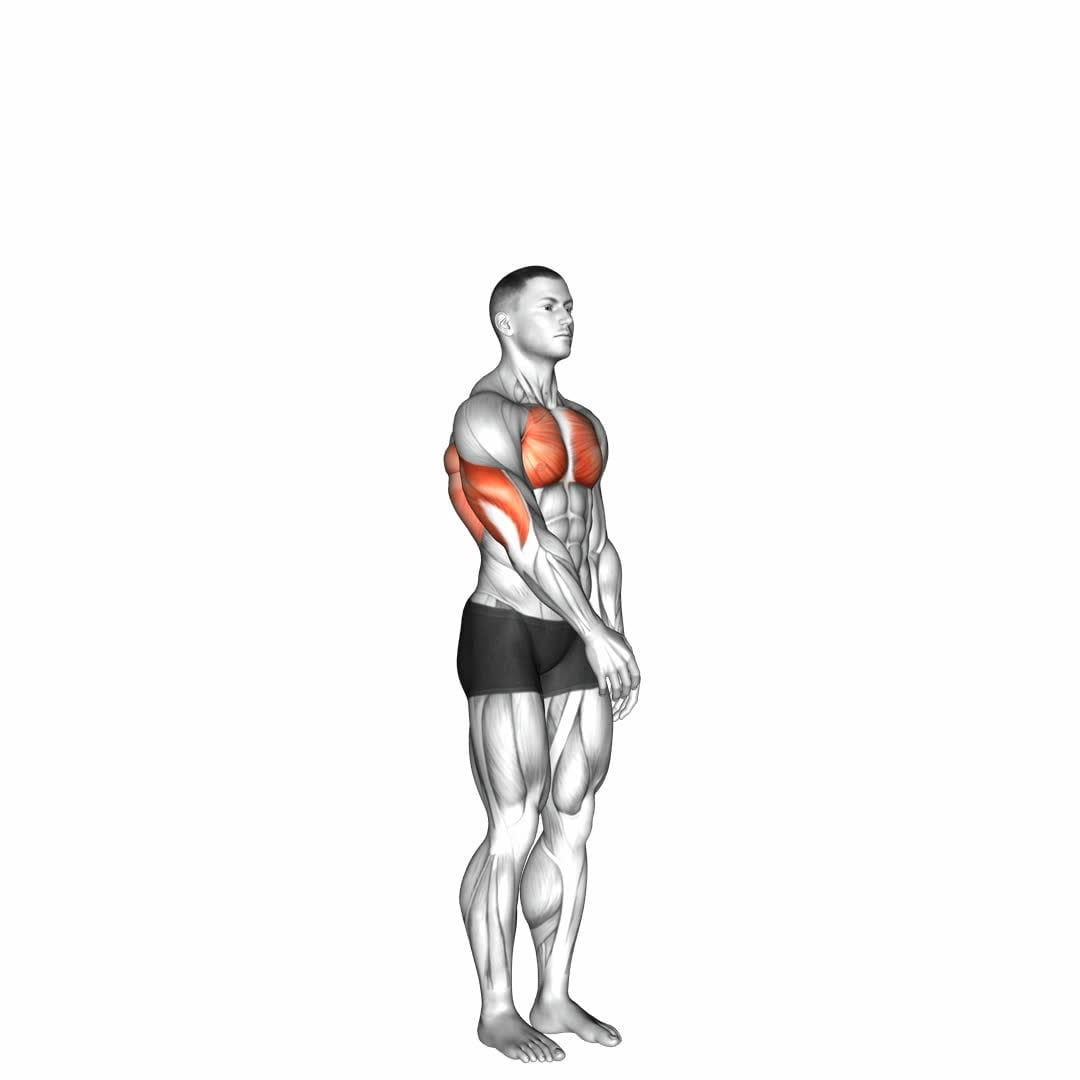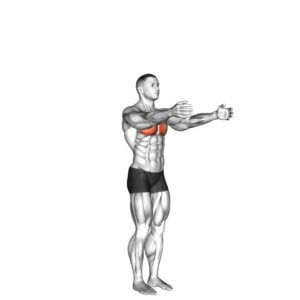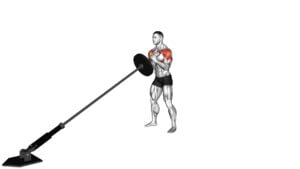Shoulder – Adduction – Video Exercise Guide & Tips

Are you looking to strengthen your shoulders and improve your range of motion?
Watch This Exercise Video
In this video exercise guide, we will show you how to perform shoulder adduction exercises effectively. With the help of proper form and technique, you can target the muscles responsible for bringing your arms closer to your body.
Whether you're a beginner or an experienced fitness enthusiast, these tips will help you prevent injuries and maximize your results.
Let's get started!
Key Takeaways
- Shoulder adduction exercises can strengthen the muscles surrounding the shoulder joint.
- These exercises can improve stability and prevent injuries in the shoulder.
- Shoulder adduction exercises can enhance range of motion in the shoulder.
- These exercises can aid in reducing pain and inflammation in the shoulder joint.
Benefits of Shoulder Adduction Exercises
You can experience several benefits from performing shoulder adduction exercises. These exercises aren't only beneficial for athletes looking to improve their performance but also for individuals undergoing shoulder rehabilitation. By engaging in shoulder adduction exercises, athletes can strengthen the muscles surrounding the shoulder joint, which can lead to improved stability and prevent injuries. Additionally, these exercises help to enhance the overall range of motion in the shoulder, allowing athletes to perform a wider range of movements with ease.
For individuals undergoing shoulder rehabilitation, shoulder adduction exercises can be incredibly beneficial in restoring strength and function to the injured shoulder. These exercises target the specific muscles involved in adduction, helping to rebuild and strengthen them after an injury or surgery. Furthermore, shoulder adduction exercises can aid in reducing pain and inflammation in the shoulder joint, promoting a faster recovery process.
Transitioning to the next section, in order to perform shoulder adduction exercises effectively, you'll need specific equipment that targets the shoulder muscles.
Equipment Needed for Shoulder Adduction Exercises
To effectively perform shoulder adduction exercises, it's essential to have the appropriate equipment that targets the muscles surrounding the shoulder joint. Two common pieces of equipment that can be used for shoulder adduction exercises are resistance bands and dumbbells.
Resistance bands are a versatile and cost-effective option for shoulder adduction exercises. They come in different levels of resistance, allowing you to gradually increase the intensity as your strength improves. To perform shoulder adduction exercises with resistance bands, you can simply attach the band to a sturdy anchor point and pull it towards your body, engaging the muscles in your shoulder.
Dumbbells are another effective tool for shoulder adduction exercises. They provide a greater range of motion and allow you to target specific muscles more effectively. To perform shoulder adduction exercises with dumbbells, you can hold a dumbbell in each hand and bring your arms towards your body, squeezing your shoulder blades together.
Incorporating resistance bands or dumbbells into your shoulder adduction exercises can help you build strength and improve the stability of your shoulder joint. Now that you know the equipment needed, let's move on to the next section, which will discuss the proper form and technique for shoulder adduction exercises.
Proper Form and Technique for Shoulder Adduction Exercises
Execute shoulder adduction exercises with proper form and technique to maximize the effectiveness and safety of the exercise. Proper technique is essential not only for achieving optimal results but also for injury prevention. When performing shoulder adduction exercises, it's crucial to maintain correct posture and alignment throughout the movement.
To begin, stand tall with your feet shoulder-width apart and engage your core muscles. Keep your shoulders relaxed and down, away from your ears. Start by holding a dumbbell in each hand with your palms facing inward. Slowly bring your arms down and across your body, towards the midline, while keeping your elbows slightly bent. Be sure to control the movement and avoid using momentum.
Throughout the exercise, focus on contracting your shoulder muscles and maintaining a smooth, controlled motion. Don't let your shoulders roll forward or hunch your back. Keep your chest lifted and your spine neutral. It's important to avoid any jerky or sudden movements that could put unnecessary stress on your joints.
Remember to start with a weight that you can comfortably handle and gradually increase the resistance as your strength improves. By following proper form and technique, you can effectively target your shoulder muscles while minimizing the risk of injury.
Variations and Progressions for Shoulder Adduction Exercises
Maintain correct posture and alignment while performing shoulder adduction exercises to maximize effectiveness and safety. Explore various variations and progressions for this exercise.
One simple progression is to increase the resistance or weight used during the exercise. This can be done by using dumbbells, resistance bands, or machines that provide adjustable resistance. Gradually increase the weight or resistance as you become stronger to continue challenging your muscles and promoting growth.
Another variation is to perform the exercise on an unstable surface, such as a stability ball or a balance board. This adds an element of instability, requiring your muscles to work harder to stabilize your body while performing the movement. This can help improve your balance and core strength in addition to targeting the muscles involved in shoulder adduction.
You can also modify the exercise by changing the angle at which you perform it. Instead of performing shoulder adduction exercises in a seated or standing position, try performing them in a lying position, either on your back or on your side. This changes the angle of resistance and can target the muscles in a slightly different way.
Tips for Injury Prevention and Recovery During Shoulder Adduction Exercises
For optimal injury prevention and recovery during shoulder adduction exercises, prioritize proper warm-up and cool-down routines.
Before starting any exercise, it's important to warm up your muscles, tendons, and ligaments to increase blood flow and flexibility. This can be done through dynamic stretching or light cardio exercises. By doing so, you prepare your body for the upcoming workout and reduce the risk of injury.
During shoulder adduction exercises, it's crucial to maintain proper form and technique. This includes keeping your shoulder blades pulled back and down, engaging your core muscles, and avoiding any sudden or jerky movements. It's also important to start with lighter weights and gradually increase the intensity as your strength and stability improve.
After completing your shoulder adduction exercise routine, it's essential to cool down properly. This helps to reduce muscle soreness and prevent any potential injuries. You can do this by performing static stretches and using foam rollers to release any tension in the muscles. Additionally, incorporating recovery techniques such as icing the shoulder or using a massage ball can help to reduce inflammation and promote faster recovery.
Frequently Asked Questions
How Many Sets and Reps Should I Do for Shoulder Adduction Exercises?
To determine the appropriate number of sets and reps for shoulder adduction exercises, it's important to consider your fitness level and goals.
Shoulder adduction exercise variations can be performed with proper form and technique to target specific muscles.
To avoid injury, start with a moderate number of sets and reps, such as 2-3 sets of 8-12 reps.
As you progress, you can increase the intensity and volume of your workouts.
Always listen to your body and consult with a fitness professional if needed.
Can Shoulder Adduction Exercises Help With Shoulder Impingement?
Shoulder adduction exercises can be beneficial for shoulder impingement. By strengthening the rotator cuff muscles and improving shoulder stability, these exercises can help alleviate impingement symptoms.
Incorporating shoulder adduction exercises into your routine can promote proper shoulder mechanics and reduce the risk of further impingement.
Consult with a healthcare professional or a qualified exercise specialist to ensure you're performing these exercises correctly and safely. Remember, consistency and proper form are key for optimal results.
Are There Any Alternatives to Using Dumbbells for Shoulder Adduction Exercises?
Looking for alternatives to dumbbells for shoulder adduction exercises?
Resistance bands can be a great option. They provide a different type of resistance that challenges your muscles in a unique way. Using resistance bands can help improve muscle strength, stability, and flexibility in your shoulders.
Plus, they're portable and versatile, allowing you to perform adduction exercises anywhere.
Can Shoulder Adduction Exercises Help Improve Posture?
Shoulder adduction exercises can have positive effects on your posture. By strengthening the muscles involved in shoulder adduction, such as the pectoralis major and latissimus dorsi, you can improve your upper body strength and stability.
These exercises help to counteract the forward rounding of the shoulders that often occurs due to poor posture. By incorporating shoulder adduction exercises into your routine, you can promote better alignment and improve your overall posture.
How Often Should I Include Shoulder Adduction Exercises in My Workout Routine?
Including shoulder adduction exercises in your workout routine can have numerous benefits. These exercises can help strengthen the muscles in your shoulders, improve posture, and enhance overall upper body strength.
To maximize the benefits, it's recommended to perform shoulder adduction exercises two to three times a week. However, it's important to avoid common mistakes such as using excessive weight or sacrificing proper form.
Always consult with a professional trainer to ensure you're performing these exercises correctly.
Conclusion
In conclusion, shoulder adduction exercises are beneficial for improving strength and stability in the shoulder joint.
By using the proper equipment and maintaining proper form, individuals can target and engage the muscles involved in shoulder adduction effectively.
Variations and progressions can be incorporated to challenge and further develop shoulder adduction strength.
Following these tips and techniques can help prevent injuries and aid in recovery during shoulder adduction exercises.

Author
Years ago, the spark of my life’s passion ignited in my mind the moment I stepped into the local gym for the first time. The inaugural bead of perspiration, the initial endeavor, the very first surge of endorphins, and a sense of pride that washed over me post-workout marked the beginning of my deep-seated interest in strength sports, fitness, and sports nutrition. This very curiosity blossomed rapidly into a profound fascination, propelling me to earn a Master’s degree in Physical Education from the Academy of Physical Education in Krakow, followed by a Sports Manager diploma from the Jagiellonian University. My journey of growth led me to gain more specialized qualifications, such as being a certified personal trainer with a focus on sports dietetics, a lifeguard, and an instructor for wellness and corrective gymnastics. Theoretical knowledge paired seamlessly with practical experience, reinforcing my belief that the transformation of individuals under my guidance was also a reflection of my personal growth. This belief holds true even today. Each day, I strive to push the boundaries and explore new realms. These realms gently elevate me to greater heights. The unique combination of passion for my field and the continuous quest for growth fuels my drive to break new ground.







